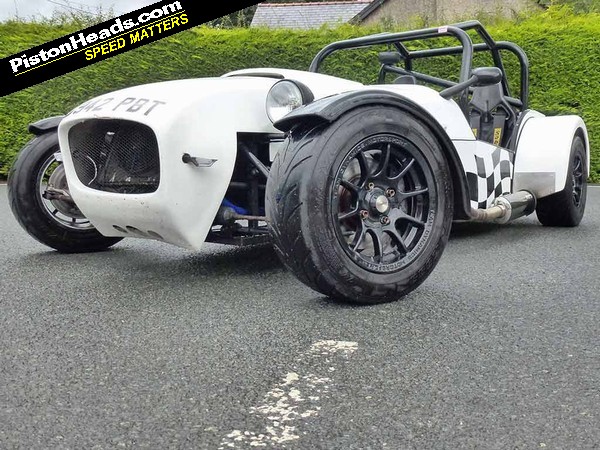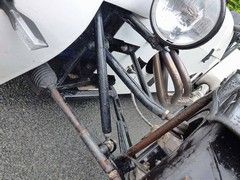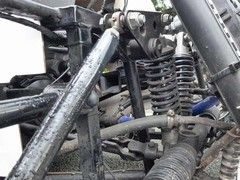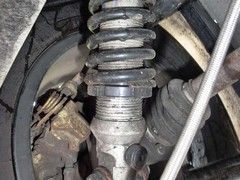Car set-up basics: part two
Sean puts his new set-up skills to the test on his own car

I've dabbled with car set-up before after reading forums and books. But having a practical demonstration really brings home how awful car setup can badly affect handling. So dialling in neutral settings - as advocated by BR Racing when trying to work towards a set-up during my tuition - gave me a baseline to work from. Following that, it was a case of tweak, test and repeat.
Junk in the trunk
Before now, I'd run the rear dampers softer on the road in an attempt to give a bit more compliance. This was a mistake. The car's front-mid engine layout and 450kg mass (the engine and gearbox weighing not much over 65kg) means adding two occupants and a tank of fuel towards the rear is a significant proportion of extra mass, making the nose go light.
As a result, unless you trail the brake on turn-in to weight up the front, it can feel understeery, with not that much bite at corner entry and a tendency to wander wide as you pick up the throttle. My fault entirely due to poor set-up, not the car's.
The rear dampers were stiffened initially to try and cure this. Compression and rebound is on one circuit, but it should at least give me some more support at the back in theory. In turn this will stop the car pitching as much from the rear axle under load and over bumps.
Stiffening up
After going stiffer on the rear, progressively winding the adjusters to nine out of 13 clicks (originally on five) I achieved a decent balance - it felt more planted, less like it wanted to pogo around or roll from the rear, and more composed as a result. But the front still didn't quite have the bite I wanted.
Adding the mass of a driver and passenger to the static setup the Indy R was still probably 'nose-up', so I wanted to try and get it with a slight rake while loaded to tip more weight over the front axle. I increased the ride height at the back by 10mm (no point in lowering the front, the sump's already been cracked once...) and the car did feel pointier. But it could be a bit more extreme, as I'm not bothered about comfort on road given the benefits it brings on track.
Step by step
So rather than just chucking negative camber and toe out at the front end, I worked through it methodically, one change at a time. Make multiple adjustments and you won't be able to diagnose what has made the car better or worse, so you'll be lost - do one thing at a time, recording your changes as you go, and you'll have a good idea where the improvement (hopefully) has come from, allowing you to address the next set-up change.
I started with one degree of toe out to help neutralise the understeer on turn-in, but there was still a bit of mid-corner slip from the fronts in faster bends. That meant adding more negative camber.
Dialling in a degree and a half of negative camber at the front meant that as the chassis loads up and the car rolls, the tyre becomes flatter to the Tarmac, maximising the contact patch when you most need the grip.
Running -1.5 degrees (or thereabouts) certainly helped and the car felt hooked onto a line in quicker constant and closing radius corners, without ruining the balance of the car.
Overall the geometry and damping adjustments have made a massive difference even on road, proving how small set-up changes can transform the feel of a car. I'm pleased with the result too, as without splashing out on expensive modifications my car now performs much better with just a bit of time, effort and knowledge. A success, then.
[/quote]
Not true,what you'll miss with that approach is how the different changes interact with each other. But it's a good place to start and should mean you get it more right than wrong.
From memory it had a Sierra Estate front anti-roll bar (so thicker than normal). Thing was so stiff both wheels used to just go up-&-down together! Not independantly!
This was changed for a rose jointed tie bar arrangement a Club Member sold, and the result was that now the front wheels moved independantly of each other. Much better :-)
Don't really know why ...... but it reminded me of the fact that Colin Chapman .... and pretty much all subsequent set up geniuses at Lotus .... have generally extolled the virtues of (relatively) softly sprung but well damped when it comes to suspension.
Certainly seems to work on the Elise. Handles wonderfully well but still feels fairly compliant.
It can often be a mistake to go too hard .... if you'll pardon the expression!

On my previous car i made it faster with a re-map but kept the suspension pretty stock. On the new one I'm running at stock power levels but instead i've made a bunch of chassis changes (arb's/geometry/lighter components etc) which has made the car much more enjoyable on twisty roads - its a much better car than the last one as a result.
It can often be a mistake to go too hard .... if you'll pardon the expression!

can any of the resident beards explain what I'm missing?
can any of the resident beards explain what I'm missing?

As I said: I've learnt so incredibly much from these guys.
Gassing Station | General Gassing | Top of Page | What's New | My Stuff







